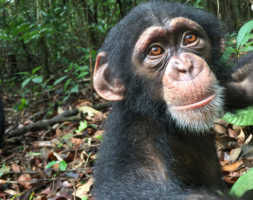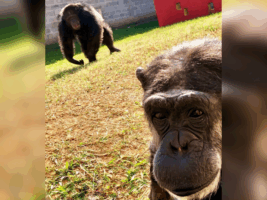KIDNAPPED BABY COMES BACK TO HER MOTHER
FONGOLI RESERVE, SENEGAL
Anthropologist Jill Pruetz and her team put Aimee, a female 9 month-old baby chimpanzee, inside a bag less than 15 meters away of a group of chimpanzees that they were accompanied for more than 7 years. And they prayed for her. A young chimpanzee, Mike, got near, smelled the surprising delivery, took it and gave it to his mother Tia, who was taking care of her own wounds.
The group began to walk and the humans followed them. Tia carried the baby, but sometimes Mike also helped to carry her. The mother was hurt because of an attack of hunters\’ dogs, that a few days before had kidnapped her baby girl. Mike and Tia knew that those humans who were accompanying them closely were much different from those who attacked them violently a few days before.
Dr. Jil Pruetz, who was at Ohio University, United States, where she is a teacher, had been informed by her field manager Dondo "Johnny" Kante that they had rescued a baby chimpanzee a few hours before and that she was Tia\’s daughter. She did not think twice and came back to Senegal, to Fongoli Reserve, where she works for many years, to try the almost impossible – gave the baby back to her mother, something that had never happened before with chimpanzees in the wild.
Dr. Robert W. Shumaker, scientist from Great Ape Trust, in Iowa, which sponsor a part of Jill\’s work in Senegal, declared: "I do not know any similar situation to this one that was a success, as it was this time". Everyone consider that Mike\’s attitude, who took the baby, gave to his mother and helped to carry her, was a extraordinary case that proves that chimpanzees has awareness of their community.
Jill\’s manager in Fongoli, Kante, who was offered the baby by the hunters some days before, was the one who was able to identify the baby as Tia\’s daughter and convinced the hunter to give the baby to him, as long as he had committed a crime.
Jill Pruetz was recognized for her work in Fongoli, Senegal, some months ago, when National Geographic, which also helps in her research, showed her to the world, and also a group of low lands chimpanzees accompanied by her, which live in caves and hunt small mammals to feed.
President, GAP Project Internationa

 Español
Español
 Português
Português








